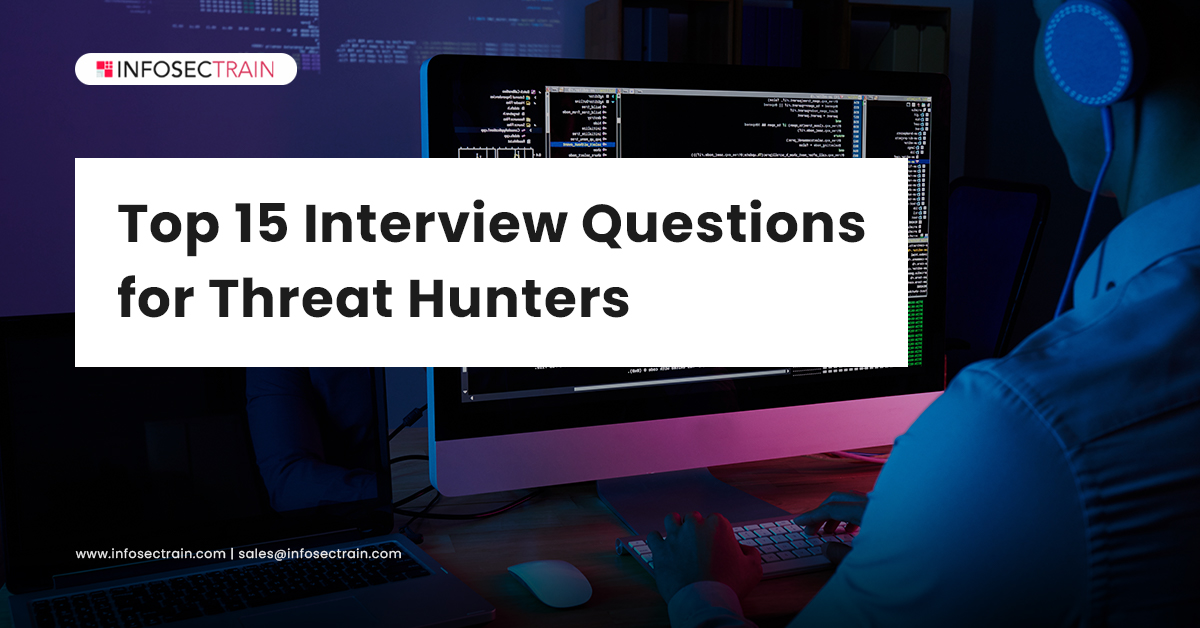Top 15 Interview Questions for Threat Hunters
Threat Hunting is the process of searching for cyber threats that are lurking undetected in the network, datasets, and endpoints. The process involves digging deep into the environment to check for malicious actors. To avoid such attacks, threat hunting is critical. Attackers or hackers can remain undetected within the network for months, silently collecting data login credentials and gathering your confidential information.

Over time, threat hunting and incident response approaches have improved. Advanced methodologies are being used by organizations to identify risks by using professional threat hunters even before damage or loss occurs. Our Threat Hunting Professional Online Training Course enhances your abilities and assists you in comprehending threats and their goals.
Threat Hunting Professional is an online training course created by InfosecTrain that teaches you how to seek risks proactively and become a better-balanced penetration tester. Our skilled educators will teach you the fundamentals and procedures of threat hunting, as well as step-by-step instructions for hunting for threats across the network.
InfosecTrain has created a few essential interview questions and answers that can help you in the interviews; here are they:
1. What is Threat Hunting?
Cyber threat hunting is a type of active cyber defense. It’s “the practice of scanning across networks proactively and repeatedly to find and identify advanced threats that elude traditional security solutions.”
2. Can you differentiate between Threat Hunting and Pen Testing?
Pen testing reveals how an adversary might get access to your environment. It highlights the dangers of not protecting the environment by demonstrating how various vulnerabilities might be exploited and exposing risky IT practices.
Threat hunting informs you of who is already there in your environment and what they are doing. It discusses the current situation of the environment and the challenges posed to the company.
3. Is it possible to find nothing in some Threat Hunting exercises?
Yes, it is theoretically possible to find nothing in some threat hunting exercises, but it is not a complete waste of time because we may discover a few other vulnerabilities that we didn’t ever experience or thought existed. So, it is always good to conduct a thorough threat hunting process even if we don’t find any potential threats.
4. Can we utilize what’s detected in the hunt to improve organizations’ security?
Yes, without a doubt. Security teams can use the threat data obtained during a hunt to understand why they couldn’t detect the threats and then devise a strategy for detecting the suspicions in future attacks. Skilled hunters understand that a large part of their job entails gathering danger data that can be utilized to develop more robust, more effective defenses.
5. What is MITRE ATT&CK?
MITRE ATT&CK® means MITRE Adversarial Tactics, Techniques, and Common Knowledge, and it is a trademark of MITRE (ATT&CK). The MITRE ATT&CK framework is a collected body of knowledge and a paradigm for cyber adversary behavior, representing the many stages of an adversary’s attack life cycle and the technologies they are known to target.
6. What is the use of Mitre ATT&CK?
Threat hunters, red teamers, and defenders use the MITRE ATT&CK paradigm to identify cyberattacks better and evaluate an organization’s vulnerability.
7. What are the different types of Threat Hunting techniques?
Different Threat Hunting techniques are
- Target-Driven
- Technique-Driven
- Volumetric Analysis
- Frequency Analysis
- Clustering Analysis
- Grouping Analysis
8. What is the primary goal of Threat Hunting?
The purpose of threat hunting is to keep an eye on everyday operations and traffic across the network, looking for any irregularities that could lead to a full-fledged breach.
9. Tell me something about the Threat Hunt hypothesis?
A threat hunting hypothesis is a theory or proposed interpretation based on minimal data from a secure environment. It is then used as a jumping-off point for further inquiry.
10. What is the difference between Threat Intelligence and Threat Hunting?
Threat hunting and threat intelligence are two separate security disciplines that can complement each other. Subscribing to a threat intelligence feed, on the other hand, does not eliminate the requirement to threat hunt your network. Even if hazards haven’t been detected in the wild, a competent threat hunter can detect them.
11. Can you differentiate between Incident Response and Threat Hunting?
Threat hunting is a hypothesis-driven process that involves looking for threats that have slipped through the cracks and are now lurking in the network. Incident response is a reactive approach that occurs when an intrusion detection system recognizes an issue and creates an alert, whereas threat hunting is a proactive strategy.
12. What is proactive Threat Hunting?
The process of proactively exploring across networks or datasets to detect and respond to sophisticated cyberthreats that circumvent standard rule, or signature-based security controls is known as proactive threat hunting.
13. Do you think a Threat Hunter must examine multiple areas?
Yes, a threat hunter and the rest of the team should be looking into various areas. Just because you’ve come up with a certain theory doesn’t imply that you should limit your investigation to that region. Rather, the threat hunter must look into other areas in order to acquire a complete picture of your IT system. This includes your regular IT systems, virtual machines, servers, and even your production environment; make sure you have the appropriate backups in place in these cases.
14. What are the two most popular types of Threat Hunting exercises?
- Continuous Monitor or Testing Mode
- On-Demand Investigation Mode
15. What is data leakage?
Data leakage is defined as the separation or departure of a data packet from the location where it was supposed to be kept in technical terms, particularly as it relates to the threat hunter.
Threat Hunting with InfosecTrain:
InfosecTrain is a leading cloud and security provider with certified and expert trainers who explain concepts in simple terms and clear all your doubts. In this Threat Hunting Training course from InfosecTrain, you will learn concepts like Threat Hunting terminologies, Threat Hunting hypotheses, Network Traffic Hunting, Web Hunting, Endpoint Hunting, Malware Hunting, Hunting with ELK, and many more. So, check out InfosecTrain for the best courses.








 1800-843-7890 (India)
1800-843-7890 (India)